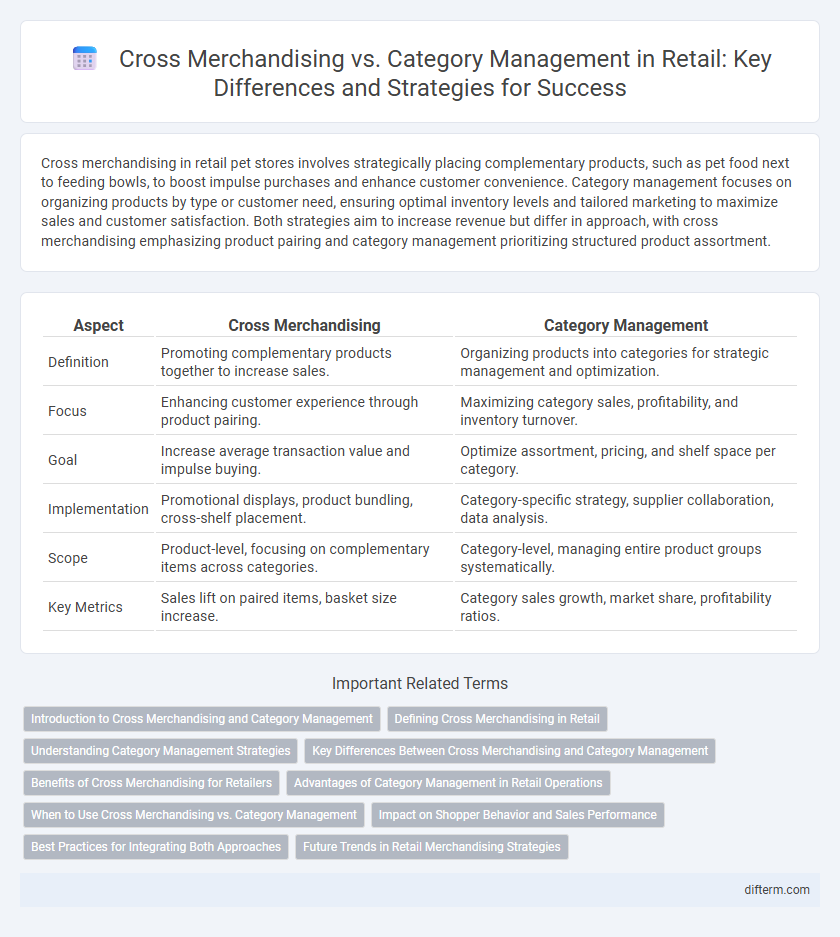Cross merchandising in retail pet stores involves strategically placing complementary products, such as pet food next to feeding bowls, to boost impulse purchases and enhance customer convenience. Category management focuses on organizing products by type or customer need, ensuring optimal inventory levels and tailored marketing to maximize sales and customer satisfaction. Both strategies aim to increase revenue but differ in approach, with cross merchandising emphasizing product pairing and category management prioritizing structured product assortment.
Table of Comparison
| Aspect | Cross Merchandising | Category Management |
|---|---|---|
| Definition | Promoting complementary products together to increase sales. | Organizing products into categories for strategic management and optimization. |
| Focus | Enhancing customer experience through product pairing. | Maximizing category sales, profitability, and inventory turnover. |
| Goal | Increase average transaction value and impulse buying. | Optimize assortment, pricing, and shelf space per category. |
| Implementation | Promotional displays, product bundling, cross-shelf placement. | Category-specific strategy, supplier collaboration, data analysis. |
| Scope | Product-level, focusing on complementary items across categories. | Category-level, managing entire product groups systematically. |
| Key Metrics | Sales lift on paired items, basket size increase. | Category sales growth, market share, profitability ratios. |
Introduction to Cross Merchandising and Category Management
Cross merchandising strategically places complementary products together to boost impulse purchases and increase overall sales, leveraging shopper behavior insights. Category management organizes products into distinct groups based on consumer needs and buying habits to optimize assortment, pricing, and shelf space for each category. Both approaches enhance retail performance by aligning product placement and inventory decisions with customer preferences and market trends.
Defining Cross Merchandising in Retail
Cross merchandising in retail involves strategically placing complementary products from different categories together to encourage additional purchases and enhance customer convenience. This technique increases basket size by visually linking related items, such as pairing wines with cheese or chips with dips. Unlike category management, which organizes products within a single category for optimized selection and turnover, cross merchandising focuses on inter-category sales stimulation through product adjacency and visual appeal.
Understanding Category Management Strategies
Category management strategies focus on organizing products into logical groups to maximize sales and streamline inventory, enhancing shopper experience through targeted assortment and pricing decisions. Cross merchandising involves placing complementary products from different categories together to encourage impulse purchases and increase average basket size. Retailers leveraging category management prioritize data-driven insights to optimize shelf space, while cross merchandising tactics support those strategies by promoting product relevance and convenience.
Key Differences Between Cross Merchandising and Category Management
Cross merchandising focuses on strategically placing complementary products together to drive impulse purchases and increase average transaction value, whereas category management involves organizing products into distinct groups based on consumer behavior and sales data to optimize inventory and shelf space. Cross merchandising emphasizes product pairing across categories, while category management centers on managing product assortments within a single category for improved merchandising effectiveness. The key difference lies in cross merchandising's goal of enhancing customer convenience through related products, as opposed to category management's analytical approach to category profitability and market segmentation.
Benefits of Cross Merchandising for Retailers
Cross merchandising enhances product visibility and encourages impulse buying by strategically placing complementary items together, increasing average transaction value. Retailers benefit from improved customer experience and streamlined inventory turnover, ultimately boosting overall sales performance. This approach also supports targeted promotions and optimizes shelf space efficiency, making it a valuable tactic compared to traditional category management.
Advantages of Category Management in Retail Operations
Category management in retail optimizes product assortment and inventory by analyzing consumer behavior and sales data, leading to improved shelf space utilization and increased sales per square foot. This approach enhances supplier collaboration and enables dynamic pricing strategies, ultimately driving higher profit margins and customer satisfaction. Retailers benefit from targeted marketing campaigns and streamlined supply chain management, which reduce stockouts and excess inventory costs.
When to Use Cross Merchandising vs. Category Management
Cross merchandising is ideal for promoting complementary products together, boosting impulse purchases and enhancing the customer's shopping experience, especially during seasonal campaigns or product launches. Category management is more effective for long-term inventory organization, optimizing product assortment, and improving overall category performance through data-driven decisions. Retailers should use cross merchandising to increase average transaction value and category management to drive sustained sales growth and customer loyalty.
Impact on Shopper Behavior and Sales Performance
Cross merchandising strategically places complementary products together, boosting impulse purchases and enhancing shopper convenience, which directly increases basket size and sales volume. Category management focuses on organizing products within categories to align with shopper needs and preferences, improving product visibility and category sales through targeted assortment and pricing strategies. Both approaches influence shopper behavior by optimizing product placement and assortment, but cross merchandising drives immediate sales lifts while category management fosters long-term category growth.
Best Practices for Integrating Both Approaches
Cross merchandising enhances customer experience by strategically placing complementary products together, boosting impulse buying and increasing average basket size. Category management focuses on optimizing product assortment and pricing within specific product groups to improve sales performance and profit margins. Integrating both approaches requires aligning cross merchandising displays with category plans, leveraging data analytics to identify synergies, and coordinating store layouts to maximize overall retail efficiency and customer satisfaction.
Future Trends in Retail Merchandising Strategies
Future trends in retail merchandising reveal a shift towards integrating cross merchandising with category management to enhance personalized shopping experiences and optimize shelf space. Advanced AI and data analytics enable retailers to dynamically adjust product placements based on real-time consumer behavior, driving higher sales across complementary and category-specific items. Emphasizing sustainability and omnichannel strategies also influences merchandising tactics, ensuring seamless customer journeys and alignment with evolving shopper values.
Cross merchandising vs Category management Infographic

 difterm.com
difterm.com